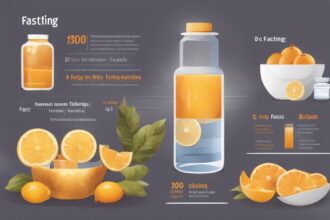Fasting has long been celebrated as a powerful tool for physical and mental rejuvenation. Among the various fasting practices, extended fasting—going without food for 24 hours or more—has gained attention for its potential to reset the body and promote detoxification. However, extended fasting can be intense, and without proper care, it may lead to discomfort or strain. This is where the concept of gentle cleansing during extended fast comes into play. By incorporating supportive practices and mindful strategies, you can enhance the detox process while minimizing stress on your body. In this comprehensive guide, we’ll explore how to approach gentle cleansing during an extended fast, ensuring a safe and effective experience.
What Is Gentle Cleansing During Extended Fast?
Gentle cleansing during extended fast refers to the use of supportive techniques and habits that aid the body’s natural detoxification processes without adding unnecessary strain. During an extended fast, the body shifts into a state of autophagy, where it breaks down and recycles damaged cells, and ketosis, where it burns fat for energy. While these processes are inherently cleansing, they can sometimes lead to symptoms like fatigue, headaches, or irritability—often referred to as the “detox flu.” Gentle cleansing focuses on easing these symptoms by supporting the liver, kidneys, and lymphatic system through hydration, rest, and mild detox practices. This approach prioritizes safety and comfort, making the fasting experience more sustainable.
Why Choose Gentle Cleansing Over Aggressive Detox Methods?
Many detox programs advocate for aggressive methods like juice cleanses, herbal supplements, or enemas to “speed up” detoxification. However, during an extended fast, the body is already in a vulnerable state due to the absence of food. Aggressive detox methods can overwhelm the system, leading to dehydration, nutrient imbalances, or even organ stress. Gentle cleansing, on the other hand, works in harmony with the body’s natural rhythms. For instance, sipping warm water with lemon or engaging in light stretching can stimulate detoxification without pushing the body beyond its limits. This approach is especially beneficial for beginners or those with pre-existing health conditions. To learn more about safe fasting practices, check out our detailed guide on Fasting Basics for Beginners.
How to Support Your Body with Hydration During an Extended Fast
Hydration is the cornerstone of gentle cleansing during extended fast. Without food, the body relies heavily on fluids to flush out toxins through urine and sweat. Dehydration can exacerbate detox symptoms and hinder the cleansing process. Aim to drink at least 2–3 liters of water daily, adjusting based on your activity level and climate. Adding a pinch of high-quality sea salt to your water can help replenish electrolytes lost during fasting. Herbal teas, such as dandelion or ginger tea, can also support liver function and digestion. Avoid caffeinated or sugary drinks, as they can dehydrate you or disrupt the fasting state. For more tips on staying hydrated, read our post on Hydration Tips for Fasting.
Incorporating Rest and Relaxation for Effective Cleansing
Extended fasting is not just a physical journey but a mental and emotional one as well. Stress can hinder detoxification by elevating cortisol levels, which may slow down the body’s healing processes. Gentle cleansing during extended fast involves prioritizing rest and relaxation to support overall well-being. Take time for light meditation, deep breathing exercises, or even a warm bath with Epsom salts to soothe the body and mind. Avoid overexertion—while light movement is beneficial, intense workouts can deplete energy reserves during a fast. Sleep is also crucial; aim for 7–9 hours per night to allow your body to repair and regenerate. Explore more stress-relief techniques in our article on Mindful Practices During Fasting.
Supporting Detox with Gentle Movement and Lymphatic Drainage
While rest is essential, gentle movement can play a significant role in cleansing during an extended fast. Activities like walking, yoga, or stretching help stimulate blood flow and support the lymphatic system, which is responsible for removing waste from the body. Dry brushing, a technique where you brush your skin with a natural bristle brush before showering, can also promote lymphatic drainage and exfoliate dead skin cells. These practices are low-impact and align with the principles of gentle cleansing, ensuring you don’t overtax your body. Remember to listen to your energy levels—if you feel weak or dizzy, stop and rest. For a deeper dive into safe exercises during fasting, check out our guide on Low-Impact Workouts for Fasting.
Breaking the Fast: A Gentle Reintroduction to Food
One of the most critical aspects of gentle cleansing during extended fast is how you break the fast. Reintroducing food too quickly or with heavy meals can shock the digestive system, leading to bloating, nausea, or discomfort. Instead, start with small portions of easily digestible foods like bone broth, vegetable soups, or steamed vegetables. Avoid processed foods, sugar, and dairy initially, as they can be harder to digest after a prolonged fast. Gradually reintroduce more complex foods over a few days to allow your body to adjust. This gentle transition supports the cleansing benefits of the fast and prevents re-toxification. For a step-by-step plan, refer to our article on How to Break a Fast Safely.
Disclaimer: The information provided in this article is for educational purposes only and is not intended as medical advice. Fasting, especially extended fasting, may not be suitable for everyone, particularly individuals with certain medical conditions, pregnant or breastfeeding women, or those on specific medications. Always consult with a healthcare professional before starting any fasting or detox regimen to ensure it is safe for your individual health needs.
References
- Harvard Health Publishing – Intermittent Fasting: Surprising Update
- National Center for Biotechnology Information – Effects of Fasting on Health
- Mayo Clinic – Fasting Diet: Can It Improve My Health?
- WebMD – Detox Diets: Cleansing the Body
- Healthline – 10 Evidence-Based Health Benefits of Intermittent Fasting
This content is for informational purposes only and not a substitute for professional advice.






